HSC318 - Rural and Remote Health Program Grant Submission Project
VerifiedAdded on 2022/11/10
|7
|2541
|437
Project
AI Summary
This document presents a student's mock grant submission for a health program designed to address oral and dental health disparities in the remote Cape York region of Australia. The program aims to educate the local population, particularly young adults, on the importance of dental care and preventative practices. The submission includes an executive summary outlining the program's goals, target group, and budget, with a focus on reducing dental issues by 20% in the next three years. The program activities involve workshops, acknowledging dental issues, and exploring community mindsets. Key performance indicators (KPIs) include a reduction in dental issues, and surveys to gauge program effectiveness. The Australian Dental Association is identified as a primary funding source. The submission provides a detailed budget allocation and evaluation criteria focusing on the program's impact on dental health outcomes and practices. The program's success will be measured by a fall in dental issues in the concerned region which would provide the best result for the program.
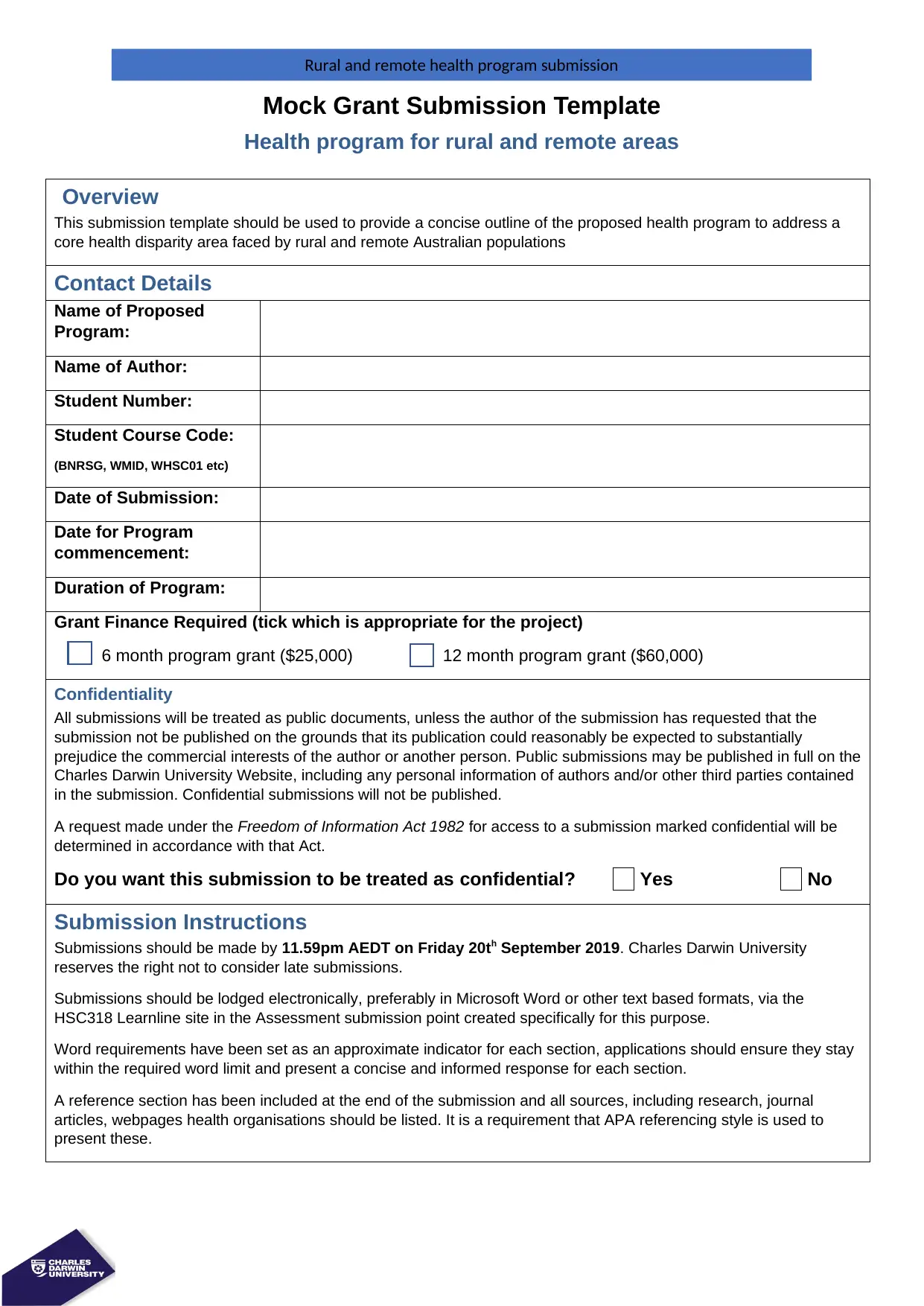
Mock Grant Submission Template
Health program for rural and remote areas
Overview
This submission template should be used to provide a concise outline of the proposed health program to address a
core health disparity area faced by rural and remote Australian populations
Contact Details
Name of Proposed
Program:
Name of Author:
Student Number:
Student Course Code:
(BNRSG, WMID, WHSC01 etc)
Date of Submission:
Date for Program
commencement:
Duration of Program:
Grant Finance Required (tick which is appropriate for the project)
6 month program grant ($25,000) 12 month program grant ($60,000)
Confidentiality
All submissions will be treated as public documents, unless the author of the submission has requested that the
submission not be published on the grounds that its publication could reasonably be expected to substantially
prejudice the commercial interests of the author or another person. Public submissions may be published in full on the
Charles Darwin University Website, including any personal information of authors and/or other third parties contained
in the submission. Confidential submissions will not be published.
A request made under the Freedom of Information Act 1982 for access to a submission marked confidential will be
determined in accordance with that Act.
Do you want this submission to be treated as confidential? Yes No
Submission Instructions
Submissions should be made by 11.59pm AEDT on Friday 20th September 2019. Charles Darwin University
reserves the right not to consider late submissions.
Submissions should be lodged electronically, preferably in Microsoft Word or other text based formats, via the
HSC318 Learnline site in the Assessment submission point created specifically for this purpose.
Word requirements have been set as an approximate indicator for each section, applications should ensure they stay
within the required word limit and present a concise and informed response for each section.
A reference section has been included at the end of the submission and all sources, including research, journal
articles, webpages health organisations should be listed. It is a requirement that APA referencing style is used to
present these.
Rural and remote health program submission
Health program for rural and remote areas
Overview
This submission template should be used to provide a concise outline of the proposed health program to address a
core health disparity area faced by rural and remote Australian populations
Contact Details
Name of Proposed
Program:
Name of Author:
Student Number:
Student Course Code:
(BNRSG, WMID, WHSC01 etc)
Date of Submission:
Date for Program
commencement:
Duration of Program:
Grant Finance Required (tick which is appropriate for the project)
6 month program grant ($25,000) 12 month program grant ($60,000)
Confidentiality
All submissions will be treated as public documents, unless the author of the submission has requested that the
submission not be published on the grounds that its publication could reasonably be expected to substantially
prejudice the commercial interests of the author or another person. Public submissions may be published in full on the
Charles Darwin University Website, including any personal information of authors and/or other third parties contained
in the submission. Confidential submissions will not be published.
A request made under the Freedom of Information Act 1982 for access to a submission marked confidential will be
determined in accordance with that Act.
Do you want this submission to be treated as confidential? Yes No
Submission Instructions
Submissions should be made by 11.59pm AEDT on Friday 20th September 2019. Charles Darwin University
reserves the right not to consider late submissions.
Submissions should be lodged electronically, preferably in Microsoft Word or other text based formats, via the
HSC318 Learnline site in the Assessment submission point created specifically for this purpose.
Word requirements have been set as an approximate indicator for each section, applications should ensure they stay
within the required word limit and present a concise and informed response for each section.
A reference section has been included at the end of the submission and all sources, including research, journal
articles, webpages health organisations should be listed. It is a requirement that APA referencing style is used to
present these.
Rural and remote health program submission
Paraphrase This Document
Need a fresh take? Get an instant paraphrase of this document with our AI Paraphraser
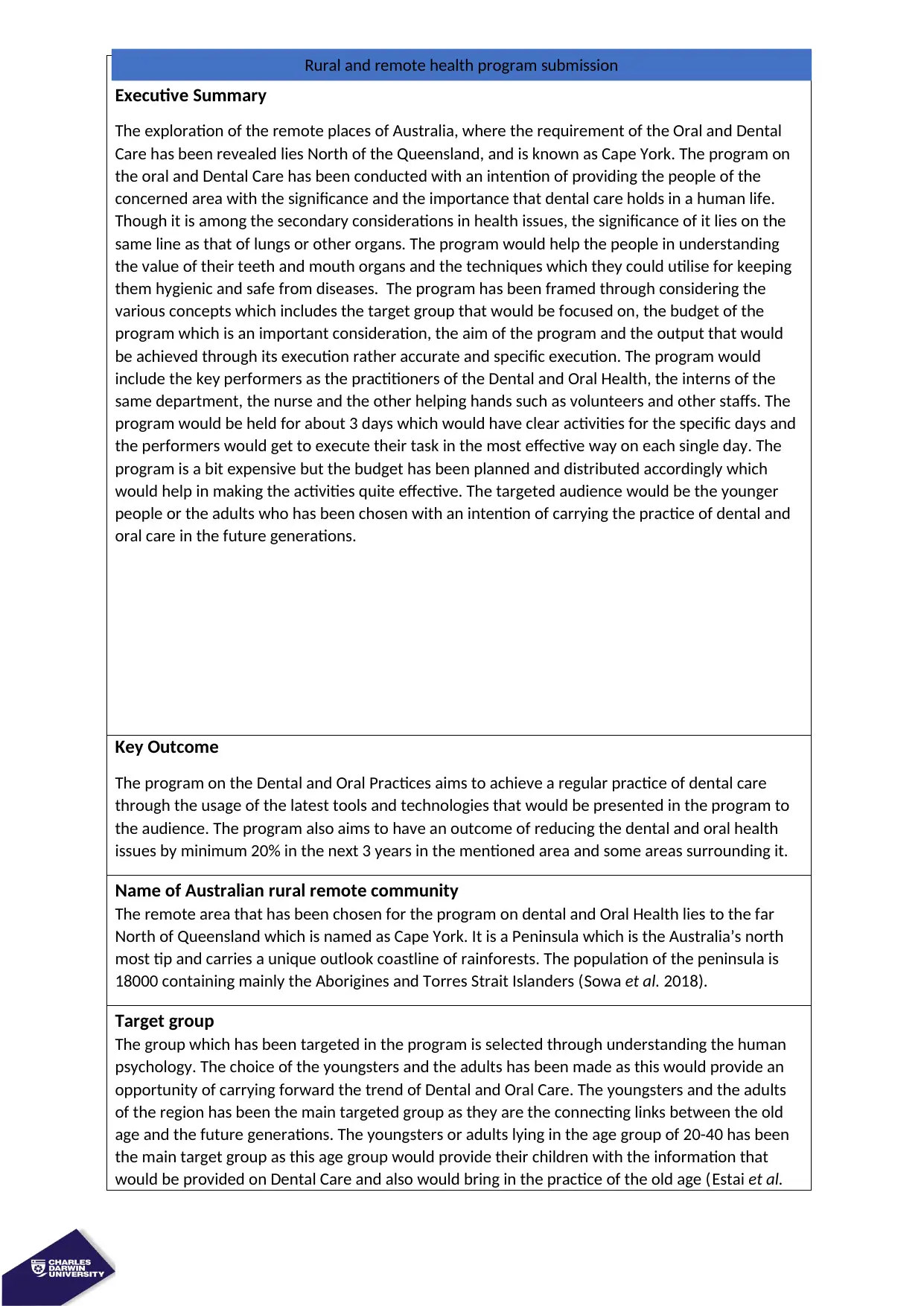
Executive Summary
The exploration of the remote places of Australia, where the requirement of the Oral and Dental
Care has been revealed lies North of the Queensland, and is known as Cape York. The program on
the oral and Dental Care has been conducted with an intention of providing the people of the
concerned area with the significance and the importance that dental care holds in a human life.
Though it is among the secondary considerations in health issues, the significance of it lies on the
same line as that of lungs or other organs. The program would help the people in understanding
the value of their teeth and mouth organs and the techniques which they could utilise for keeping
them hygienic and safe from diseases. The program has been framed through considering the
various concepts which includes the target group that would be focused on, the budget of the
program which is an important consideration, the aim of the program and the output that would
be achieved through its execution rather accurate and specific execution. The program would
include the key performers as the practitioners of the Dental and Oral Health, the interns of the
same department, the nurse and the other helping hands such as volunteers and other staffs. The
program would be held for about 3 days which would have clear activities for the specific days and
the performers would get to execute their task in the most effective way on each single day. The
program is a bit expensive but the budget has been planned and distributed accordingly which
would help in making the activities quite effective. The targeted audience would be the younger
people or the adults who has been chosen with an intention of carrying the practice of dental and
oral care in the future generations.
Key Outcome
The program on the Dental and Oral Practices aims to achieve a regular practice of dental care
through the usage of the latest tools and technologies that would be presented in the program to
the audience. The program also aims to have an outcome of reducing the dental and oral health
issues by minimum 20% in the next 3 years in the mentioned area and some areas surrounding it.
Name of Australian rural remote community
The remote area that has been chosen for the program on dental and Oral Health lies to the far
North of Queensland which is named as Cape York. It is a Peninsula which is the Australia’s north
most tip and carries a unique outlook coastline of rainforests. The population of the peninsula is
18000 containing mainly the Aborigines and Torres Strait Islanders (Sowa et al. 2018).
Target group
The group which has been targeted in the program is selected through understanding the human
psychology. The choice of the youngsters and the adults has been made as this would provide an
opportunity of carrying forward the trend of Dental and Oral Care. The youngsters and the adults
of the region has been the main targeted group as they are the connecting links between the old
age and the future generations. The youngsters or adults lying in the age group of 20-40 has been
the main target group as this age group would provide their children with the information that
would be provided on Dental Care and also would bring in the practice of the old age (Estai et al.
Rural and remote health program submission
The exploration of the remote places of Australia, where the requirement of the Oral and Dental
Care has been revealed lies North of the Queensland, and is known as Cape York. The program on
the oral and Dental Care has been conducted with an intention of providing the people of the
concerned area with the significance and the importance that dental care holds in a human life.
Though it is among the secondary considerations in health issues, the significance of it lies on the
same line as that of lungs or other organs. The program would help the people in understanding
the value of their teeth and mouth organs and the techniques which they could utilise for keeping
them hygienic and safe from diseases. The program has been framed through considering the
various concepts which includes the target group that would be focused on, the budget of the
program which is an important consideration, the aim of the program and the output that would
be achieved through its execution rather accurate and specific execution. The program would
include the key performers as the practitioners of the Dental and Oral Health, the interns of the
same department, the nurse and the other helping hands such as volunteers and other staffs. The
program would be held for about 3 days which would have clear activities for the specific days and
the performers would get to execute their task in the most effective way on each single day. The
program is a bit expensive but the budget has been planned and distributed accordingly which
would help in making the activities quite effective. The targeted audience would be the younger
people or the adults who has been chosen with an intention of carrying the practice of dental and
oral care in the future generations.
Key Outcome
The program on the Dental and Oral Practices aims to achieve a regular practice of dental care
through the usage of the latest tools and technologies that would be presented in the program to
the audience. The program also aims to have an outcome of reducing the dental and oral health
issues by minimum 20% in the next 3 years in the mentioned area and some areas surrounding it.
Name of Australian rural remote community
The remote area that has been chosen for the program on dental and Oral Health lies to the far
North of Queensland which is named as Cape York. It is a Peninsula which is the Australia’s north
most tip and carries a unique outlook coastline of rainforests. The population of the peninsula is
18000 containing mainly the Aborigines and Torres Strait Islanders (Sowa et al. 2018).
Target group
The group which has been targeted in the program is selected through understanding the human
psychology. The choice of the youngsters and the adults has been made as this would provide an
opportunity of carrying forward the trend of Dental and Oral Care. The youngsters and the adults
of the region has been the main targeted group as they are the connecting links between the old
age and the future generations. The youngsters or adults lying in the age group of 20-40 has been
the main target group as this age group would provide their children with the information that
would be provided on Dental Care and also would bring in the practice of the old age (Estai et al.
Rural and remote health program submission
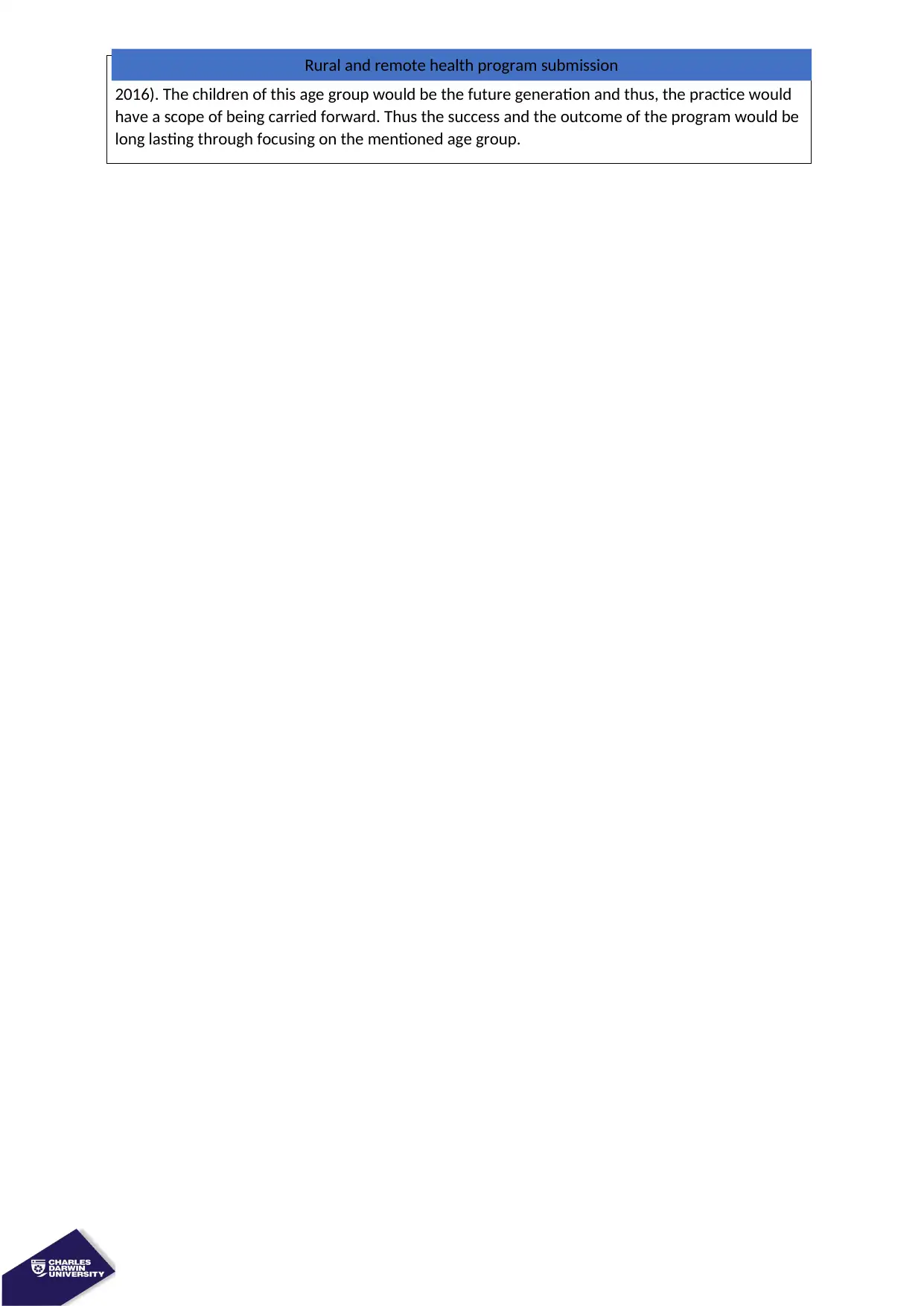
2016). The children of this age group would be the future generation and thus, the practice would
have a scope of being carried forward. Thus the success and the outcome of the program would be
long lasting through focusing on the mentioned age group.
Rural and remote health program submission
have a scope of being carried forward. Thus the success and the outcome of the program would be
long lasting through focusing on the mentioned age group.
Rural and remote health program submission
⊘ This is a preview!⊘
Do you want full access?
Subscribe today to unlock all pages.

Trusted by 1+ million students worldwide
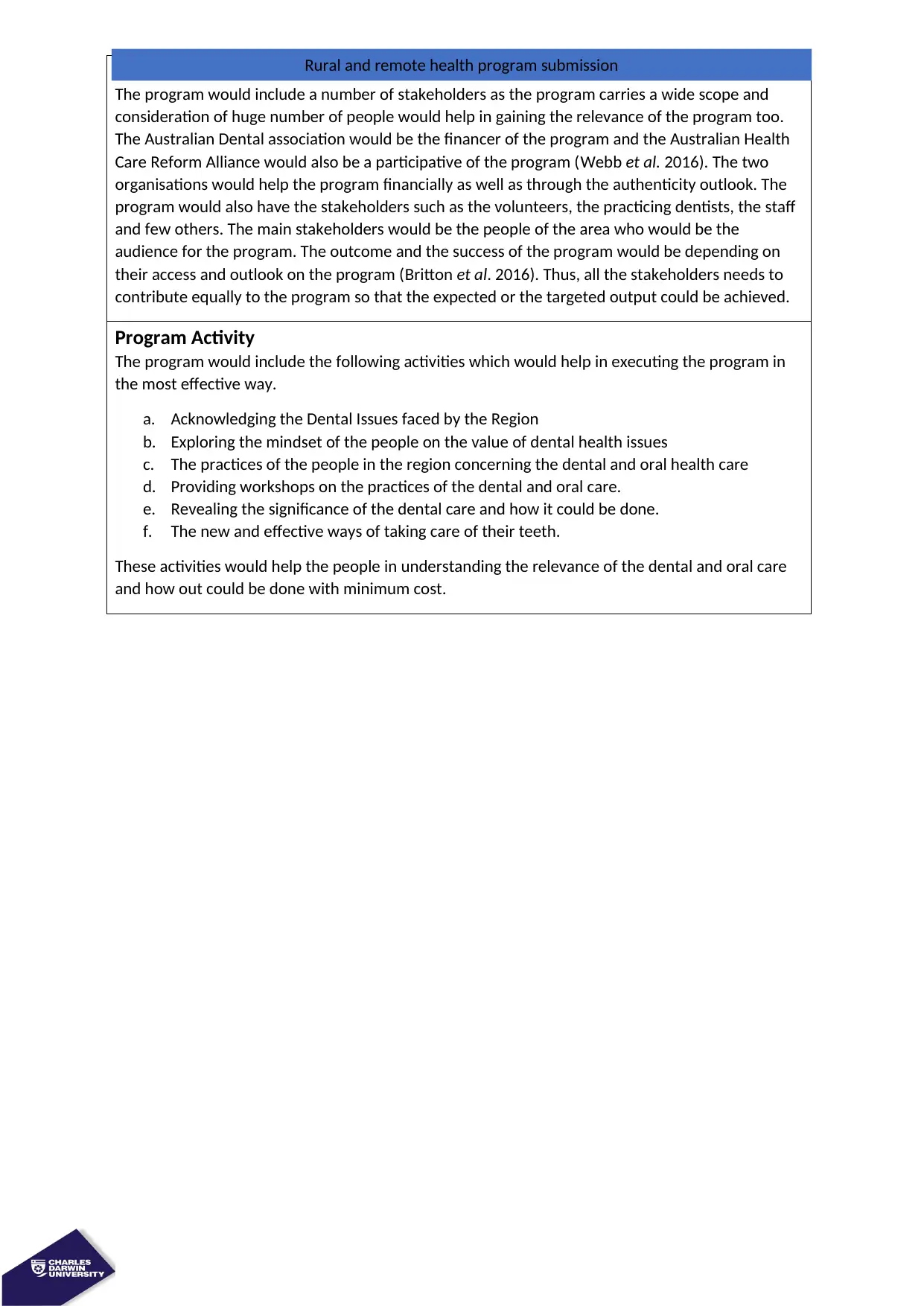
Stakeholders
The program would include a number of stakeholders as the program carries a wide scope and
consideration of huge number of people would help in gaining the relevance of the program too.
The Australian Dental association would be the financer of the program and the Australian Health
Care Reform Alliance would also be a participative of the program (Webb et al. 2016). The two
organisations would help the program financially as well as through the authenticity outlook. The
program would also have the stakeholders such as the volunteers, the practicing dentists, the staff
and few others. The main stakeholders would be the people of the area who would be the
audience for the program. The outcome and the success of the program would be depending on
their access and outlook on the program (Britton et al. 2016). Thus, all the stakeholders needs to
contribute equally to the program so that the expected or the targeted output could be achieved.
Program Activity
The program would include the following activities which would help in executing the program in
the most effective way.
a. Acknowledging the Dental Issues faced by the Region
b. Exploring the mindset of the people on the value of dental health issues
c. The practices of the people in the region concerning the dental and oral health care
d. Providing workshops on the practices of the dental and oral care.
e. Revealing the significance of the dental care and how it could be done.
f. The new and effective ways of taking care of their teeth.
These activities would help the people in understanding the relevance of the dental and oral care
and how out could be done with minimum cost.
Rural and remote health program submission
The program would include a number of stakeholders as the program carries a wide scope and
consideration of huge number of people would help in gaining the relevance of the program too.
The Australian Dental association would be the financer of the program and the Australian Health
Care Reform Alliance would also be a participative of the program (Webb et al. 2016). The two
organisations would help the program financially as well as through the authenticity outlook. The
program would also have the stakeholders such as the volunteers, the practicing dentists, the staff
and few others. The main stakeholders would be the people of the area who would be the
audience for the program. The outcome and the success of the program would be depending on
their access and outlook on the program (Britton et al. 2016). Thus, all the stakeholders needs to
contribute equally to the program so that the expected or the targeted output could be achieved.
Program Activity
The program would include the following activities which would help in executing the program in
the most effective way.
a. Acknowledging the Dental Issues faced by the Region
b. Exploring the mindset of the people on the value of dental health issues
c. The practices of the people in the region concerning the dental and oral health care
d. Providing workshops on the practices of the dental and oral care.
e. Revealing the significance of the dental care and how it could be done.
f. The new and effective ways of taking care of their teeth.
These activities would help the people in understanding the relevance of the dental and oral care
and how out could be done with minimum cost.
Rural and remote health program submission
Paraphrase This Document
Need a fresh take? Get an instant paraphrase of this document with our AI Paraphraser
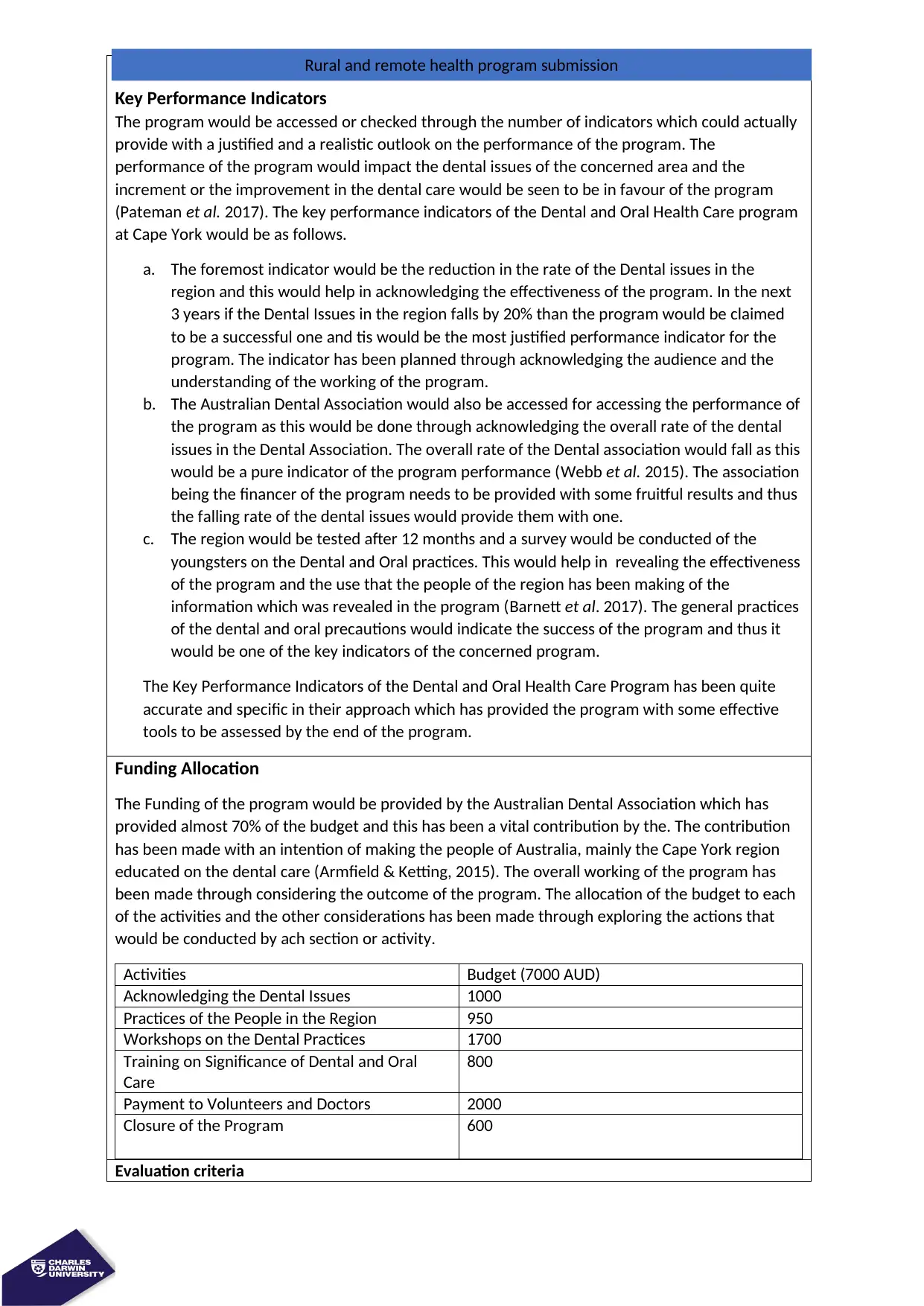
Key Performance Indicators
The program would be accessed or checked through the number of indicators which could actually
provide with a justified and a realistic outlook on the performance of the program. The
performance of the program would impact the dental issues of the concerned area and the
increment or the improvement in the dental care would be seen to be in favour of the program
(Pateman et al. 2017). The key performance indicators of the Dental and Oral Health Care program
at Cape York would be as follows.
a. The foremost indicator would be the reduction in the rate of the Dental issues in the
region and this would help in acknowledging the effectiveness of the program. In the next
3 years if the Dental Issues in the region falls by 20% than the program would be claimed
to be a successful one and tis would be the most justified performance indicator for the
program. The indicator has been planned through acknowledging the audience and the
understanding of the working of the program.
b. The Australian Dental Association would also be accessed for accessing the performance of
the program as this would be done through acknowledging the overall rate of the dental
issues in the Dental Association. The overall rate of the Dental association would fall as this
would be a pure indicator of the program performance (Webb et al. 2015). The association
being the financer of the program needs to be provided with some fruitful results and thus
the falling rate of the dental issues would provide them with one.
c. The region would be tested after 12 months and a survey would be conducted of the
youngsters on the Dental and Oral practices. This would help in revealing the effectiveness
of the program and the use that the people of the region has been making of the
information which was revealed in the program (Barnett et al. 2017). The general practices
of the dental and oral precautions would indicate the success of the program and thus it
would be one of the key indicators of the concerned program.
The Key Performance Indicators of the Dental and Oral Health Care Program has been quite
accurate and specific in their approach which has provided the program with some effective
tools to be assessed by the end of the program.
Funding Allocation
The Funding of the program would be provided by the Australian Dental Association which has
provided almost 70% of the budget and this has been a vital contribution by the. The contribution
has been made with an intention of making the people of Australia, mainly the Cape York region
educated on the dental care (Armfield & Ketting, 2015). The overall working of the program has
been made through considering the outcome of the program. The allocation of the budget to each
of the activities and the other considerations has been made through exploring the actions that
would be conducted by ach section or activity.
Activities Budget (7000 AUD)
Acknowledging the Dental Issues 1000
Practices of the People in the Region 950
Workshops on the Dental Practices 1700
Training on Significance of Dental and Oral
Care
800
Payment to Volunteers and Doctors 2000
Closure of the Program 600
Evaluation criteria
Rural and remote health program submission
The program would be accessed or checked through the number of indicators which could actually
provide with a justified and a realistic outlook on the performance of the program. The
performance of the program would impact the dental issues of the concerned area and the
increment or the improvement in the dental care would be seen to be in favour of the program
(Pateman et al. 2017). The key performance indicators of the Dental and Oral Health Care program
at Cape York would be as follows.
a. The foremost indicator would be the reduction in the rate of the Dental issues in the
region and this would help in acknowledging the effectiveness of the program. In the next
3 years if the Dental Issues in the region falls by 20% than the program would be claimed
to be a successful one and tis would be the most justified performance indicator for the
program. The indicator has been planned through acknowledging the audience and the
understanding of the working of the program.
b. The Australian Dental Association would also be accessed for accessing the performance of
the program as this would be done through acknowledging the overall rate of the dental
issues in the Dental Association. The overall rate of the Dental association would fall as this
would be a pure indicator of the program performance (Webb et al. 2015). The association
being the financer of the program needs to be provided with some fruitful results and thus
the falling rate of the dental issues would provide them with one.
c. The region would be tested after 12 months and a survey would be conducted of the
youngsters on the Dental and Oral practices. This would help in revealing the effectiveness
of the program and the use that the people of the region has been making of the
information which was revealed in the program (Barnett et al. 2017). The general practices
of the dental and oral precautions would indicate the success of the program and thus it
would be one of the key indicators of the concerned program.
The Key Performance Indicators of the Dental and Oral Health Care Program has been quite
accurate and specific in their approach which has provided the program with some effective
tools to be assessed by the end of the program.
Funding Allocation
The Funding of the program would be provided by the Australian Dental Association which has
provided almost 70% of the budget and this has been a vital contribution by the. The contribution
has been made with an intention of making the people of Australia, mainly the Cape York region
educated on the dental care (Armfield & Ketting, 2015). The overall working of the program has
been made through considering the outcome of the program. The allocation of the budget to each
of the activities and the other considerations has been made through exploring the actions that
would be conducted by ach section or activity.
Activities Budget (7000 AUD)
Acknowledging the Dental Issues 1000
Practices of the People in the Region 950
Workshops on the Dental Practices 1700
Training on Significance of Dental and Oral
Care
800
Payment to Volunteers and Doctors 2000
Closure of the Program 600
Evaluation criteria
Rural and remote health program submission
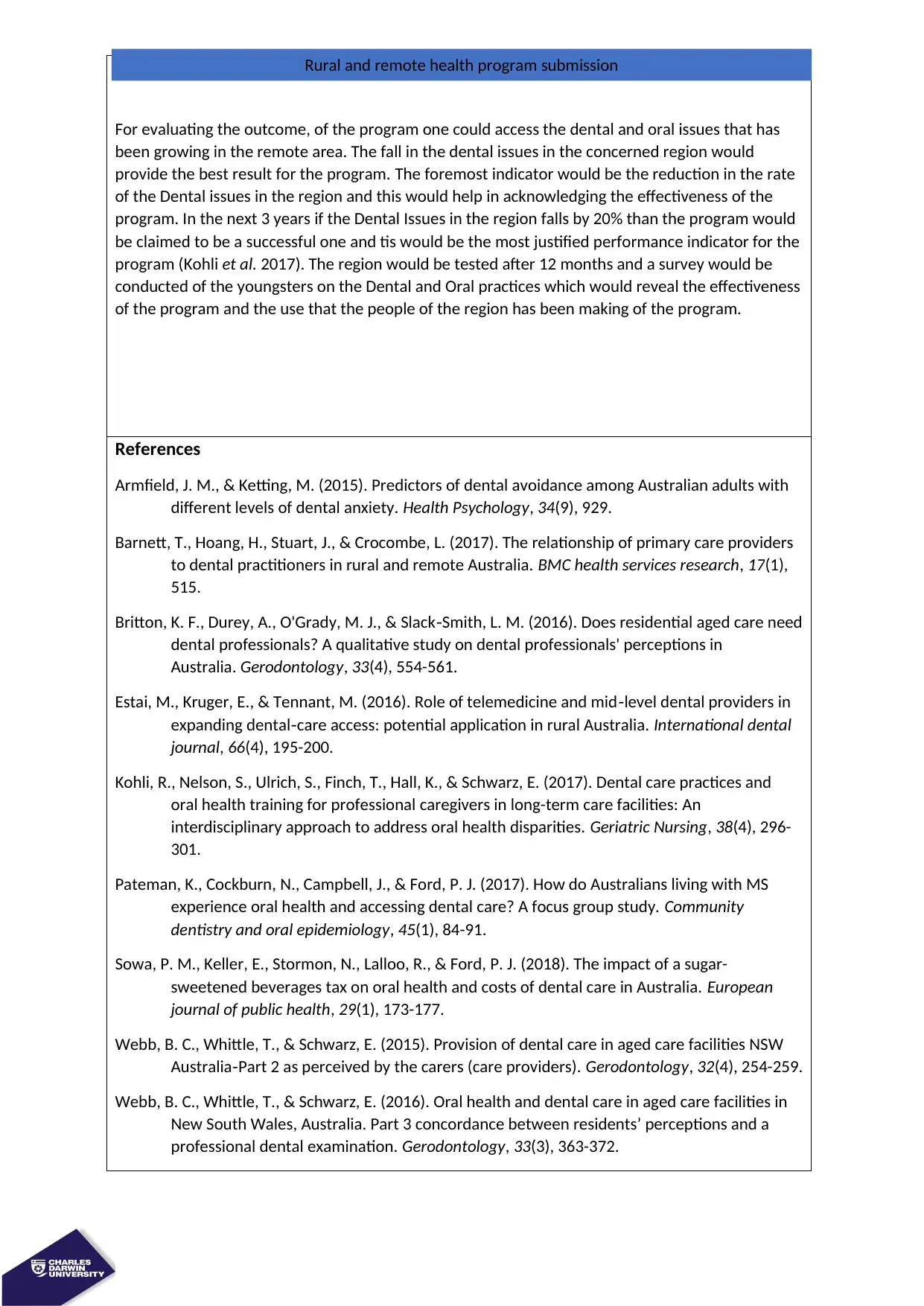
For evaluating the outcome, of the program one could access the dental and oral issues that has
been growing in the remote area. The fall in the dental issues in the concerned region would
provide the best result for the program. The foremost indicator would be the reduction in the rate
of the Dental issues in the region and this would help in acknowledging the effectiveness of the
program. In the next 3 years if the Dental Issues in the region falls by 20% than the program would
be claimed to be a successful one and tis would be the most justified performance indicator for the
program (Kohli et al. 2017). The region would be tested after 12 months and a survey would be
conducted of the youngsters on the Dental and Oral practices which would reveal the effectiveness
of the program and the use that the people of the region has been making of the program.
References
Armfield, J. M., & Ketting, M. (2015). Predictors of dental avoidance among Australian adults with
different levels of dental anxiety. Health Psychology, 34(9), 929.
Barnett, T., Hoang, H., Stuart, J., & Crocombe, L. (2017). The relationship of primary care providers
to dental practitioners in rural and remote Australia. BMC health services research, 17(1),
515.
Britton, K. F., Durey, A., O'Grady, M. J., & Slack‐Smith, L. M. (2016). Does residential aged care need
dental professionals? A qualitative study on dental professionals' perceptions in
Australia. Gerodontology, 33(4), 554-561.
Estai, M., Kruger, E., & Tennant, M. (2016). Role of telemedicine and mid‐level dental providers in
expanding dental‐care access: potential application in rural Australia. International dental
journal, 66(4), 195-200.
Kohli, R., Nelson, S., Ulrich, S., Finch, T., Hall, K., & Schwarz, E. (2017). Dental care practices and
oral health training for professional caregivers in long-term care facilities: An
interdisciplinary approach to address oral health disparities. Geriatric Nursing, 38(4), 296-
301.
Pateman, K., Cockburn, N., Campbell, J., & Ford, P. J. (2017). How do Australians living with MS
experience oral health and accessing dental care? A focus group study. Community
dentistry and oral epidemiology, 45(1), 84-91.
Sowa, P. M., Keller, E., Stormon, N., Lalloo, R., & Ford, P. J. (2018). The impact of a sugar-
sweetened beverages tax on oral health and costs of dental care in Australia. European
journal of public health, 29(1), 173-177.
Webb, B. C., Whittle, T., & Schwarz, E. (2015). Provision of dental care in aged care facilities NSW
Australia‐Part 2 as perceived by the carers (care providers). Gerodontology, 32(4), 254-259.
Webb, B. C., Whittle, T., & Schwarz, E. (2016). Oral health and dental care in aged care facilities in
New South Wales, Australia. Part 3 concordance between residents’ perceptions and a
professional dental examination. Gerodontology, 33(3), 363-372.
Rural and remote health program submission
been growing in the remote area. The fall in the dental issues in the concerned region would
provide the best result for the program. The foremost indicator would be the reduction in the rate
of the Dental issues in the region and this would help in acknowledging the effectiveness of the
program. In the next 3 years if the Dental Issues in the region falls by 20% than the program would
be claimed to be a successful one and tis would be the most justified performance indicator for the
program (Kohli et al. 2017). The region would be tested after 12 months and a survey would be
conducted of the youngsters on the Dental and Oral practices which would reveal the effectiveness
of the program and the use that the people of the region has been making of the program.
References
Armfield, J. M., & Ketting, M. (2015). Predictors of dental avoidance among Australian adults with
different levels of dental anxiety. Health Psychology, 34(9), 929.
Barnett, T., Hoang, H., Stuart, J., & Crocombe, L. (2017). The relationship of primary care providers
to dental practitioners in rural and remote Australia. BMC health services research, 17(1),
515.
Britton, K. F., Durey, A., O'Grady, M. J., & Slack‐Smith, L. M. (2016). Does residential aged care need
dental professionals? A qualitative study on dental professionals' perceptions in
Australia. Gerodontology, 33(4), 554-561.
Estai, M., Kruger, E., & Tennant, M. (2016). Role of telemedicine and mid‐level dental providers in
expanding dental‐care access: potential application in rural Australia. International dental
journal, 66(4), 195-200.
Kohli, R., Nelson, S., Ulrich, S., Finch, T., Hall, K., & Schwarz, E. (2017). Dental care practices and
oral health training for professional caregivers in long-term care facilities: An
interdisciplinary approach to address oral health disparities. Geriatric Nursing, 38(4), 296-
301.
Pateman, K., Cockburn, N., Campbell, J., & Ford, P. J. (2017). How do Australians living with MS
experience oral health and accessing dental care? A focus group study. Community
dentistry and oral epidemiology, 45(1), 84-91.
Sowa, P. M., Keller, E., Stormon, N., Lalloo, R., & Ford, P. J. (2018). The impact of a sugar-
sweetened beverages tax on oral health and costs of dental care in Australia. European
journal of public health, 29(1), 173-177.
Webb, B. C., Whittle, T., & Schwarz, E. (2015). Provision of dental care in aged care facilities NSW
Australia‐Part 2 as perceived by the carers (care providers). Gerodontology, 32(4), 254-259.
Webb, B. C., Whittle, T., & Schwarz, E. (2016). Oral health and dental care in aged care facilities in
New South Wales, Australia. Part 3 concordance between residents’ perceptions and a
professional dental examination. Gerodontology, 33(3), 363-372.
Rural and remote health program submission
⊘ This is a preview!⊘
Do you want full access?
Subscribe today to unlock all pages.

Trusted by 1+ million students worldwide
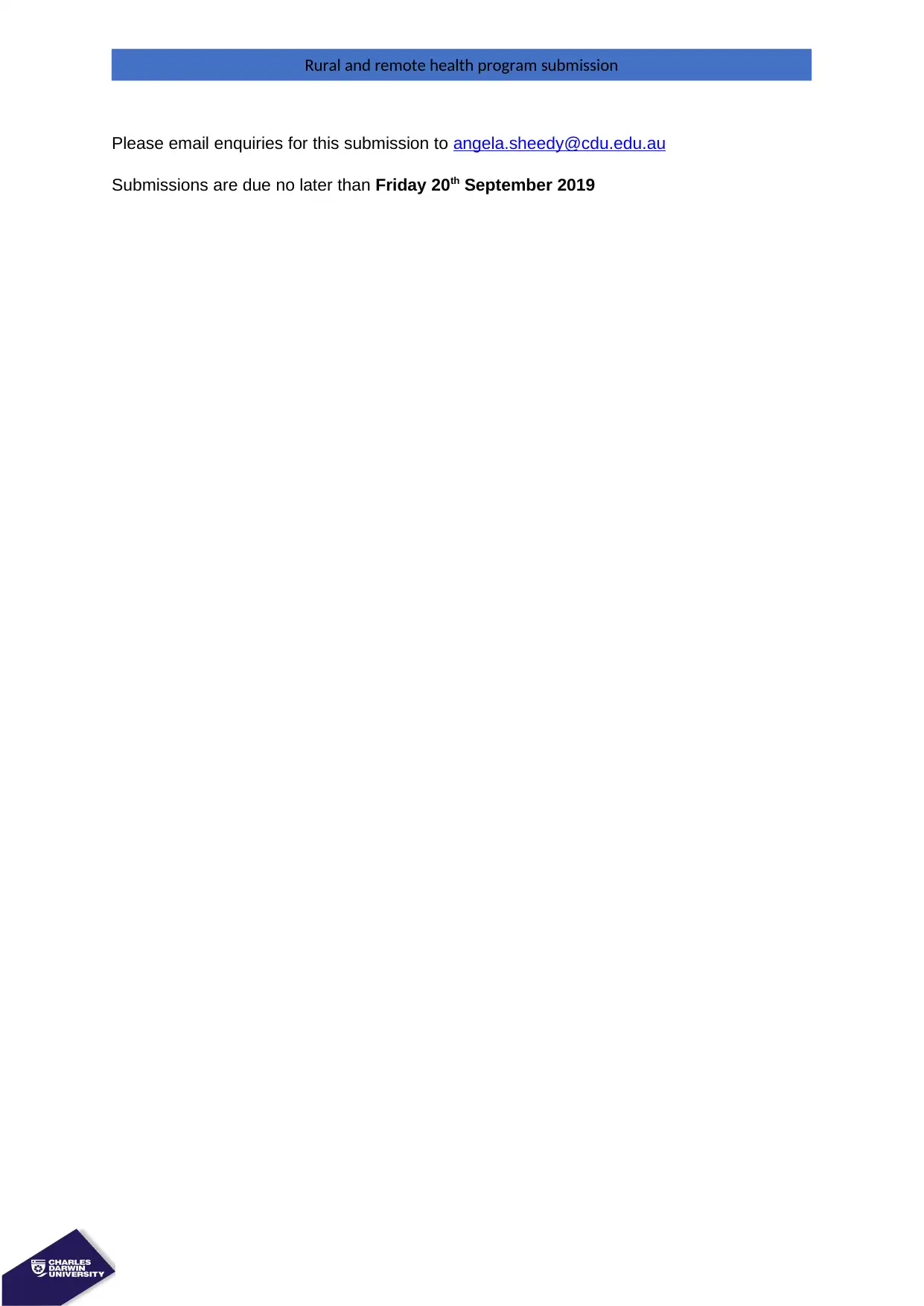
Please email enquiries for this submission to angela.sheedy@cdu.edu.au
Submissions are due no later than Friday 20th September 2019
Rural and remote health program submission
Submissions are due no later than Friday 20th September 2019
Rural and remote health program submission
1 out of 7
Your All-in-One AI-Powered Toolkit for Academic Success.
+13062052269
info@desklib.com
Available 24*7 on WhatsApp / Email
![[object Object]](/_next/static/media/star-bottom.7253800d.svg)
Unlock your academic potential
Copyright © 2020–2025 A2Z Services. All Rights Reserved. Developed and managed by ZUCOL.


